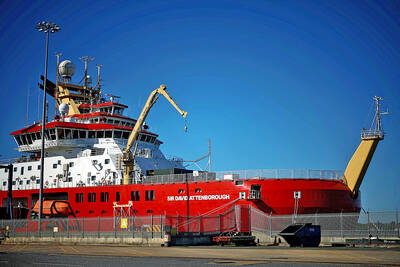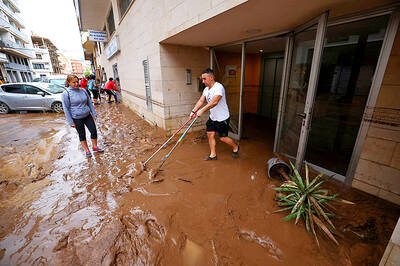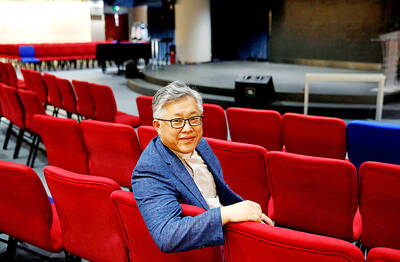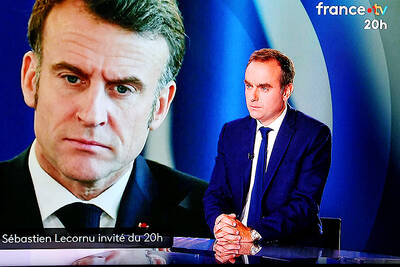Vladimir Chimitdorzhiyev was once an ardent communist who wanted to lead young people in Siberia to a Soviet paradise.
"That was a long time ago. All that is water under the bridge now," he said in his dimly lit retreat near Russia's border with Mongolia, ancient scrolls depicting Buddhist masters hanging over his shaved head.
"I am now a Buddhist monk. I've left irrelevant things behind. I've come here to learn and to teach," he said.
Tibetan teachings Chimitdorzhiyev helped revive in his ancestral homeland 6,000km southeast of Moscow are now at the forefront of a revival of interest in Buddhism in post-Soviet Russia.
After the Soviet collapse in 1991, Chimitdorzhiyev -- now known as Babu Lama -- returned to the rolling hills of his native Buryatia, brought together a dozen Buddhist priests and helped rebuild an old shrine.
Closed for decades in Soviet times, the Aginsk Datsan is now Russia's biggest Tibetan Buddhist temple.
"Peace has returned to this land ... But there was no peace here when the Datsan was closed," said Babu Lama, 46.
Under a fixed stare of a bronze statuette of Buddha, he looked out of a window and gazed at the temple's golden roofs.
Yellow banners with densely printed Tibetan inscriptions flapped in the wind, and worshippers chanted prayers inside the temple.
JAPANESE SPIES
Before Buddhism spread here from Tibet three centuries ago, Siberian tribes worshipped trees, animals and stones, their beliefs linked to other forms of Asian animism such as Japanese Shintoism.
For those tribes -- Buryats, Kalmyks and Tuvans -- Buddhism was their first source of education. In many ways, this is still the case in the most desolate villages like Aginskoye in this swathe of Siberia between Lake Baikal and Mongolia.
Following in his ancestors' footsteps, Babu Lama -- involved in various youth organizations in eastern Siberia in Soviet times -- reopened a Buddhist academy here to teach Buddhist ways to 50-odd disciples from all over Asia.
Russian Buddhism -- still linked to shamanism -- dates back to the 1700s when Empress Elizabeth, the liberal daughter of tsar Peter the Great, issued a decree recognizing Buryatia's Lamaistic beliefs and ordered the building of dozens of Buddhist temples.
Recognized as one of Russia's four official religions, Buddhism numbers 1 million followers in Russia, mainly in Buryatia -- a region once visited by the Tibetan spiritual leader, the Dalai Lama.
Both the Aginsk Datsan and the academy, built by Tibetan astrologists in the 19th century, were shut down in a clampdown on religion by Soviet dictator Josef Stalin in the 1930s.
Many lamas were arrested and deported to penal colonies, some accused of being Japanese spies.
Temples were turned into tuberculosis asylums to scare off believers.
The communists reopened a few temples after World War II to appease predominantly Buddhist tribes and even allowed theologians to travel to Mongolia to study.
BOHEMIAN PRETENSIONS
But it was only after the Soviet collapse that people like Babu Lama returned to Buryatia and Buddhist communities started to mushroom along the Mongolian border.
"And then we who doggedly carried Buddhism through the harsh Soviet years, gathered here in the 1990s and declared the temple open," said Lyubov Austermonas, a sinewy woman in her 50s and the Datsan's chief administrator.
Babu Lama's sanctuary in Buryatia -- one of Russia's poorest regions with an average monthly income of less than US$20 -- has now also turned into a fashionable travel destination for free-spending young Russians with Bohemian pretensions.
"We had this girl a few years ago, Vika from St Petersburg. She was a model," Austermonas said. "Tall, skinny and a bit conceited, she was one of those new Russians who can spend hundreds of dollars on rather useless adventures.
"But she went through this amazing transformation -- settled down in a hut, bought herself some cattle and plunged into Buddhism. She's now a famous theologian in our circles," she said.

STEPPING UP: Diminished US polar science presence mean opportunities for the UK and other countries, although China or Russia might also fill that gap, a researcher said The UK’s flagship polar research vessel is to head to Antarctica next week to help advance dozens of climate change-linked science projects, as Western nations spearhead studies there while the US withdraws. The RRS Sir David Attenborough, a state-of-the-art ship named after the renowned British naturalist, would aid research on everything from “hunting underwater tsunamis” to tracking glacier melt and whale populations. Operated by the British Antarctic Survey (BAS), the country’s polar research institute, the 15,000-tonne icebreaker — boasting a helipad, and various laboratories and gadgetry — is pivotal to the UK’s efforts to assess climate change’s impact there. “The saying goes

Floods on Sunday trapped people in vehicles and homes in Spain as torrential rain drenched the northeastern Catalonia region, a day after downpours unleashed travel chaos on the Mediterranean island of Ibiza. Local media shared videos of roaring torrents of brown water tearing through streets and submerging vehicles. National weather agency AEMET decreed the highest red alert in the province of Tarragona, warning of 180mm of rain in 12 hours in the Ebro River delta. Catalan fire service spokesman Oriol Corbella told reporters people had been caught by surprise, with people trapped “inside vehicles, in buildings, on ground floors.” Santa Barbara Mayor Josep Lluis

Police in China detained dozens of pastors of one of its largest underground churches over the weekend, a church spokesperson and relatives said, in the biggest crackdown on Christians since 2018. The detentions, which come amid renewed China-US tensions after Beijing dramatically expanded rare earth export controls last week, drew condemnation from US Secretary of State Marco Rubio, who on Sunday called for the immediate release of the pastors. Pastor Jin Mingri (金明日), founder of Zion Church, an unofficial “house church” not sanctioned by the Chinese government, was detained at his home in the southern city of Beihai on Friday evening, said

TICKING CLOCK: A path to a budget agreement was still possible, the president’s office said, as a debate on reversing an increase of the pension age carries on French President Emmanuel Macron yesterday was racing to find a new prime minister within a two-day deadline after the resignation of outgoing French Prime Minister Sebastien Lecornu tipped the country deeper into political crisis. The presidency late on Wednesday said that Macron would name a new prime minister within 48 hours, indicating that the appointment would come by this evening at the latest. Lecornu told French television in an interview that he expected a new prime minister to be named — rather than early legislative elections or Macron’s resignation — to resolve the crisis. The developments were the latest twists in three tumultuous